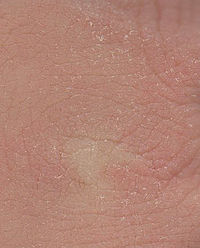- Xeroderma
-
Xeroderma, literally meaning "dry skin", is a condition involving the integumentary system, which in most cases can safely be treated with emollients and/or moisturizers. Xeroderma occurs most commonly on the scalp, lower legs, arms, the knuckles, the sides of the abdomen and thighs. Symptoms most associated with xeroderma are scaling (the visible peeling of the outer skin layer), itching and skin cracking. [1].
Contents
Common causes
Xeroderma is a very common condition. It happens more often in the winter where the cold air outside and the hot air inside creates a low relative humidity. This causes the skin to lose moisture and it may crack and peel. Bathing or hand washing too frequently, especially if one is using harsh soaps, may also contribute to xeroderma. Xeroderma can also be caused by a deficiency of vitamin A, vitamin D, systemic illness, severe sunburn, or some medication [2]. Xeroderma can also be caused by choline inhibitors. Detergents like washing powder and washing up liquid can also cause xeroderma.
Prevention
Use soap every other day to prevent dry skin. Use a pat towel technique when drying off to leave moisture on the skin.[3]
Cure
Rub emollients into the area which has xeroderma to cure it. To stop this area from getting worse cover it with a layer of petroleum jelly, which acts as a barrier to cracking.
See also
References
- ^ Information and introductory article on wrongdianosis.com
- ^ Entry on medterms.com
- ^ Lee, Doctor. "Dry Skin Prevention". http://doctorslee.com/natural-skin-care/. Retrieved 18 August 2011.
Categories:- Dermatologic terminology
- Medical sign stubs
- Dermatology stubs
Wikimedia Foundation. 2010.

